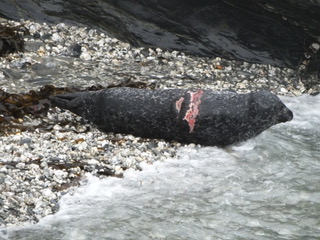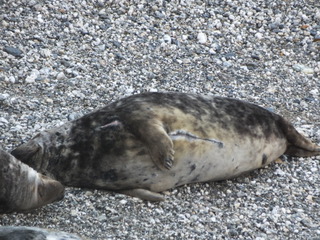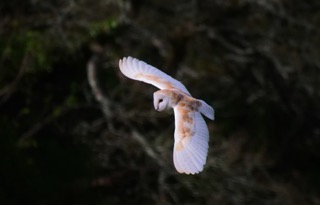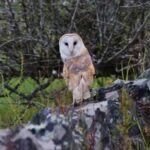Nature Notes September 2021

Roseland seals at Risk
Ellis, the Common Seal, so rare on the Roseland. Except for Ellis, the most likely seals you will see on the Roseland will be the Atlantic Grey seals. We love our Roseland seals. They are delightful to see and have been on the Roseland for many years. However, they are now at an increasing risk.
The unintentional disturbance caused by paddleboarders, kayakers and boats going too near them is becoming a serious concern. If a seal is looking at you, then you are generally too close, and the seal is likely to be distressed.
Furthermore, at this time of year, we start seeing more seals, as the females, now heavily pregnant, group on rocks, often accompanied by bull seals and non-breeding youngsters.
However, they are vulnerable because they must haul out on land for vital rest. Disturbance can make seals go back into the water too soon and, if too quickly, ripping their bodies on rocks, as well as reducing their oxygen supply, heat and energy, each of which can affect the pregnancy of the females, sometimes leading to difficulties with breathing and impacting on their life expectancy.
A confrontational approach to wildlife disturbers is not recommended. So, if you can, and feel comfortable with it, please just chat with paddleboarders, kayakers, swimmers, etc asking them to take care when wishing to observe seals. Incidentally seals can give a nasty bite if needs must!
If you do see any wildlife disturbance, please contact the Cornwall Marine and Coastal Code hotline 0345 201 2626. This is a 24 hour hotline and is also the number to ring for the Marine Strandings Network if you find any DEAD marine creature on the shore. If you find a LIVE marine creature in difficulties please ring 01825 765 546 for British Divers Marine Life Rescue.
 The Frog Prince on the Roseland. The scar may have been caused by rushing across sharp stones or glass when disturbed whilst resting.
The Frog Prince on the Roseland. The scar may have been caused by rushing across sharp stones or glass when disturbed whilst resting.
History of Roseland Seals
On a more positive note, Sue Sayer, founder of the Cornwall Seal Group Research Trust, through Rob Wells, longtime active member of the CSGRT, along with Kirstin Hardmann, Kath Wherry, and Veronica Toft, carry out essential work monitoring  and recording seals on the Roseland. They would love to know your recollections of seals here prior to 2014. Some records exist from 2011 and 2012 but they have asked me to send out an appeal via Wild Roseland to find out more about the history of seals around the Roseland.
How far back can you go with your recollections of seals on the Roseland?
Can you dredge your memory banks, journals, diaries, school projects or even family snaps? Locations, numbers of seals, dates, names of recorders, etc. Photos would be an additional bonus as individual seals might be able to be recognised as they are all uniquely patterned. Please send your memories and information to robawells@gmail.com and sue@cornwallsealgroup.co.uk copying in myself at hallruan@aol.com
 As Promised, an update on Barn Owls
As Promised, an update on Barn Owls
Thank you for your recent reports of successful Barn Owl breeding sites. I have been able to visit a few and I am delighted to say that the number to date is 7, now just 1 down on last year. It may well be that further reports will still come in, as I am writing this in early August.
Some young Barn Owls could still start making themselves heard with their peculiar hissing as they demand food from their parents. Please let me know if you hear this, as it is a sure sign of successful breeding. Contact me on 01872 501429 or email hallruan@aol.com Perhaps, despite the awful cold, wet and windy Spring the Barn Owls are doing better than we possibly could have wished for!

Thank you for supporting Wild Roseland,
David Hall
Acknowledgments to: Rob Wells and Sue Sayer for their advice and input.
Photos: Rob Wells, Seals. “Ellis” and “The Frog Prince”.
Photos: Jane Lewarne, Barn Owls.
